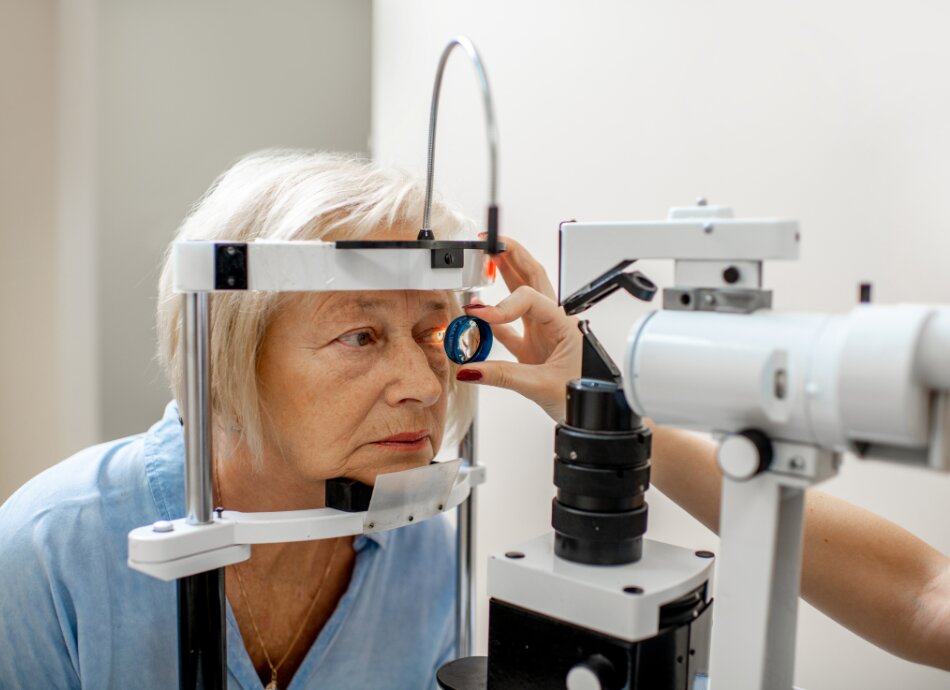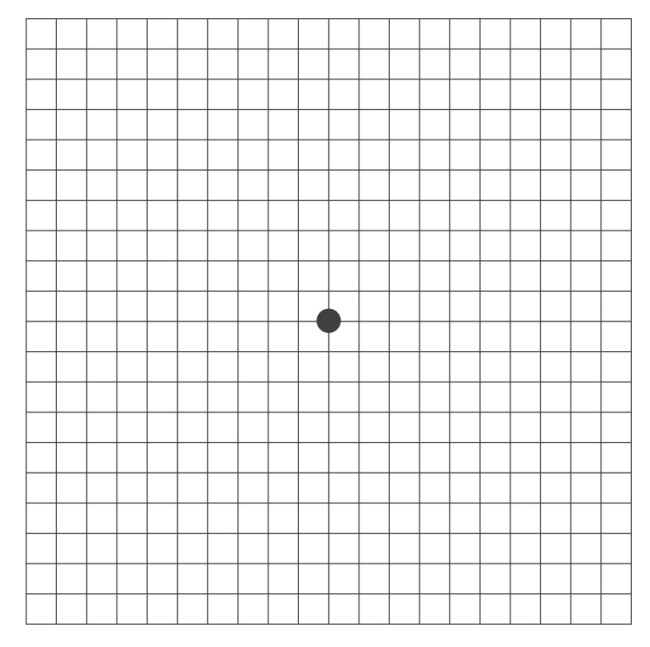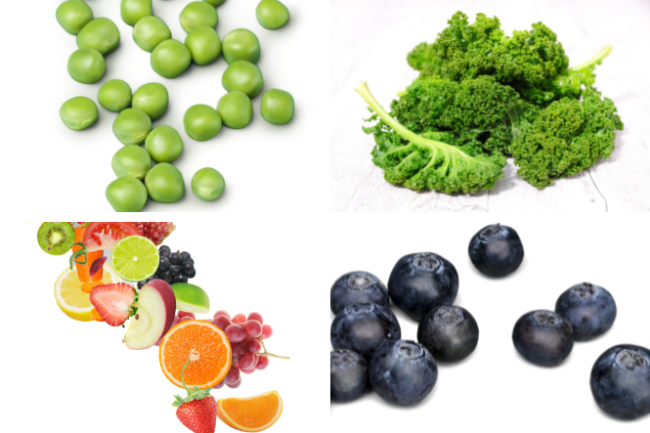Macular degeneration | Mate karu-tiro-pū
Also known as age-related macular degeneration, MD, AMD or AMRD
Key points about macular degeneration
- Macular degeneration (AMD, mate karu-tiro-pū) is the most common cause of vision loss in adults aged 50 or over with 1 in 7 affected.
- AMD may develop slowly (dry AMD) or rapidly (wet AMD).
- It causes blurring and distortion of central vision.
- Get regular eye checks and if you have concerns seek help as macular degeneration can result in blindness.

There are two types of macular degeneration – ‘dry’ and ‘wet’ AMD.
- Dry AMD is the more common and accounts for 85–90% of cases. It is a slowly progressing disease involving age-related ‘wear and tear’ to the macula. Dry AMD causes slowly worsening or distorted central vision.
- Wet AMD accounts for the remaining 10–15% of cases. It is caused by the growth of abnormal blood vessels underneath the macula. The abnormal blood vessels leak blood and fluid at the macula causing rapid loss of central vision. A scar may form leading to permanent loss of central vision. Wet AMD accounts for 4 out of 5 people with severe vision loss from AMD.
The causes of AMD are unclear; however, several risk factors for AMD have been identified:
- Increasing age is the main risk factor for AMD – 1 in 7 people over the age of 50 has some evidence of AMD and 1 in 4 over 80 years old will have some vision loss.
- Family history is also an important risk factor for AMD. If a member of your whānau has had it, you have a 50% chance of inheriting the genetic predisposition.
- Caucasian people are more commonly affected than people of other ethnicities.
- Smoking – studies suggest that smokers have at least 3–4 times the risk of developing AMD compared to non-smokers. They also develop AMD 5–10 years earlier on average. Former smokers have a lower risk compared to current smokers.
- Poor nutrition.
- An unhealthy lifestyle.
Dry AMD symptoms can develop slowly. You may not notice any symptoms in the early stages. It can take 5–10 years for symptoms to become worse. However, with wet AMD symptoms get worse quickly.
Common symptoms of AMD include:
- blurring of central vision which makes close work such as reading difficult
- colours being hard to distinguish
- dark or empty spaces in the centre of your vision which get bigger over time
- distorted central vision which makes straight lines look wavy
- difficulty recognising faces.
Eventually, if left untreated, you may experience a complete loss of central vision.
If you develop visual loss or visual distortion, see your doctor, optometrist or eye specialist as soon as possible. It could be AMD or another eye problem. The sooner you seek help, the better.
Check your vision with the AMSLER grid from Macular Degeneration New Zealand below to check for distortion in your vision. If you have AMD, check this once every week. Follow the instructions below.
- Cover one eye then focus on the dot in the centre.
- Do any of the lines look wavy, blurred or distorted?
- Are there any missing areas, or dark areas in the grid?
- Don't forget to test both eyes.

Image: Macular Degeneration NZ(external link)
Report any irregularity to your eye care professional immediately.
The grid does not replace having your macula tested by an eye care professional, particularly if you are over 50 yrs old or have any risk factors for macular degeneration.
There are a number of medical treatments available for wet AMD. These treatments do not cure the disease, but aim to stabilise vision and maintain the best vision or as long as possible. In some people, treatment can improve vision.
- Medications called anti-VEGFs (eg, Avastin, Lucentis and Eylea) have been shown to control wet AMD.
- These medications are given as an injection into the eye and may be required indefinitely. However, the interval between injections is determined on an individual basis by you and your eye specialist.
Currently, there are no medical treatments for dry MD. However, a considerable amount of research is being conducted to find a treatment. Nutritional supplements may help to slow down AMD and prevent vision loss in some people.
Nutrition
The Age Related Eye Disease Studies (AREDS I & II) are 2 major clinical trials conducted by the National Eye Institute in the US. The studies identified a specific formula of antioxidants including a high dose of zinc that can significantly reduce the relative risk of progression of AMD and delayed vision loss.
The daily amounts of these are:
- Zinc – 80 mg
- Copper – 2 mg
- Vitamin E – 400 IU
- Vitamin C – 500 mg
- Lutein – 10 mg
- Zeaxanthin – 2 mg
Any changes in diet or lifestyle should be made in consultation with your doctor.
Several studies have identified nutritional factors that may help protect against AMD. These include:
- Omega-3 fatty acids: Fish
- Carotenoids lutein and zeaxanthin: Green leafy vegetables (kale, spinach), collards, green beans, peas, fruits and some berries.
- Antioxidants: Vitamins C and E, and zinc.

Image: Canva
Including these foods in your diet is generally healthy, with the additional bonus of helping with AMD!
Other factors that may help slow the progression of AMD include:
- not smoking
- improving your diet by including green leafy vegetables, fruits, berries and fish, and avoiding high-fat foods
- maintaining a healthy lifestyle, controlling your weight and exercising regularly
- reducing exposure to ultraviolet light by wearing sunglasses.
Regular eye checks
It is important to have your eyes checked regularly by an optometrist or ophthalmologist (eye specialist). This is especially important if you are over 50 years of age, as the risk of many eye disorders increases as we age.
Everyone should have an eye health check at least every 2 years.
Apps reviewed by Healthify
You may find it useful to look at some Nutrition, exercise and weight management apps, Quit smoking apps and Vision difficulty apps.
Talk to your optometrist, doctor or eye specialist for more information, or contact the following organisations for support and information:
Macular Degeneration NZ(MDNZ)(external link)
Macular Degeneration NZ raise awareness and provide education, information and support to those with macular degeneration, their whānau and carers. They hold seminars around Aotearoa New Zealand, provide support and answers on their 0800 helpline (0800 622 852), produce quarterly Viewpoint newsletters and provide education to health professionals such as GPs, nurses and pharmacists.
Blind Low Vision NZ(external link) is the main provider of vision-related services to blind and partially sighted individuals in Aotearoa New Zealand.
The NZ Association of Optometrists(external link) 0800 4 EYECARE (0800 439 322)
Dry macular degeneration(external link) Mayo Clinic – Mayo Foundation for Medical Education and Research
Wet macular degeneration(external link) Mayo Clinic – Mayo Foundation for Medical Education and Research
Macular degeneration(external link) Eye Institute Auckland, NZ
ARMD(external link) Association of Optometrists, NZ
Apps
Nutrition, exercise and weight management apps
Quit smoking apps
Vision difficulty apps
References
What is macular degeneration(external link) Macular Degeneration New Zealand
Nutrition and supplements(external link) Macular Degeneration New Zealand
Credits: Healthify editorial team. Healthify is brought to you by Health Navigator Charitable Trust.
Reviewed by: Macular Degeneration New Zealand and Kenny Wu, Optometrist, Eye Institute, Auckland
Last reviewed:
Page last updated:





